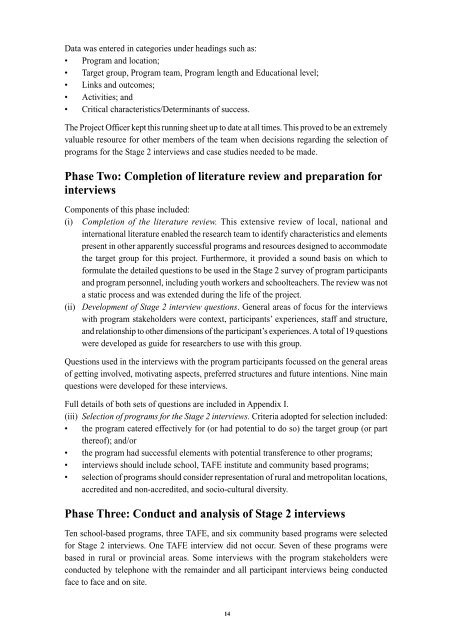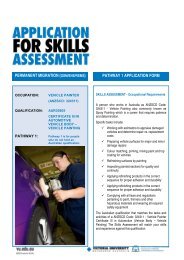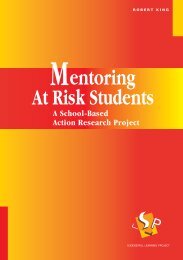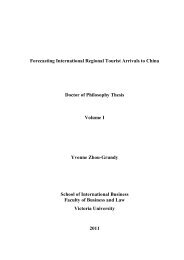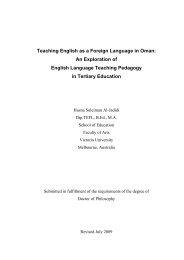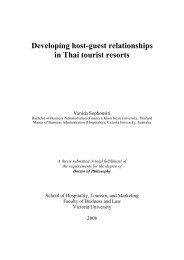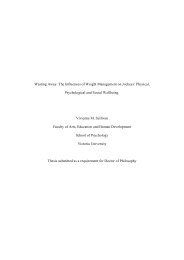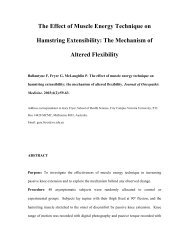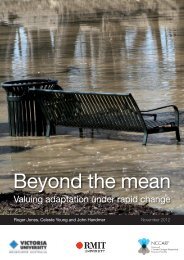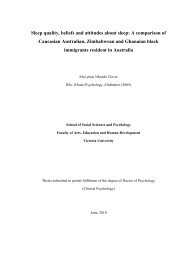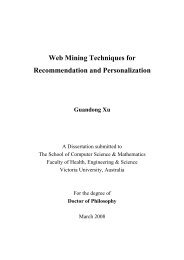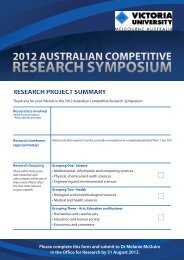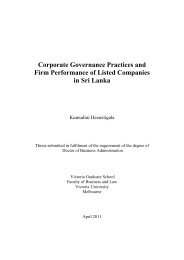Providing Education and Training for At Risk ... - Victoria University
Providing Education and Training for At Risk ... - Victoria University
Providing Education and Training for At Risk ... - Victoria University
- No tags were found...
Create successful ePaper yourself
Turn your PDF publications into a flip-book with our unique Google optimized e-Paper software.
Data was entered in categories under headings such as:• Program <strong>and</strong> location;• Target group, Program team, Program length <strong>and</strong> <strong>Education</strong>al level;• Links <strong>and</strong> outcomes;• Activities; <strong>and</strong>• Critical characteristics/Determinants of success.The Project Officer kept this running sheet up to date at all times. This proved to be an extremelyvaluable resource <strong>for</strong> other members of the team when decisions regarding the selection ofprograms <strong>for</strong> the Stage 2 interviews <strong>and</strong> case studies needed to be made.Phase Two: Completion of literature review <strong>and</strong> preparation <strong>for</strong>interviewsComponents of this phase included:(i) Completion of the literature review. This extensive review of local, national <strong>and</strong>international literature enabled the research team to identify characteristics <strong>and</strong> elementspresent in other apparently successful programs <strong>and</strong> resources designed to accommodatethe target group <strong>for</strong> this project. Furthermore, it provided a sound basis on which to<strong>for</strong>mulate the detailed questions to be used in the Stage 2 survey of program participants<strong>and</strong> program personnel, including youth workers <strong>and</strong> schoolteachers. The review was nota static process <strong>and</strong> was extended during the life of the project.(ii) Development of Stage 2 interview questions. General areas of focus <strong>for</strong> the interviewswith program stakeholders were context, participants’ experiences, staff <strong>and</strong> structure,<strong>and</strong> relationship to other dimensions of the participant’s experiences. A total of 19 questionswere developed as guide <strong>for</strong> researchers to use with this group.Questions used in the interviews with the program participants focussed on the general areasof getting involved, motivating aspects, preferred structures <strong>and</strong> future intentions. Nine mainquestions were developed <strong>for</strong> these interviews.Full details of both sets of questions are included in Appendix I.(iii) Selection of programs <strong>for</strong> the Stage 2 interviews. Criteria adopted <strong>for</strong> selection included:• the program catered effectively <strong>for</strong> (or had potential to do so) the target group (or partthereof); <strong>and</strong>/or• the program had successful elements with potential transference to other programs;• interviews should include school, TAFE institute <strong>and</strong> community based programs;• selection of programs should consider representation of rural <strong>and</strong> metropolitan locations,accredited <strong>and</strong> non-accredited, <strong>and</strong> socio-cultural diversity.Phase Three: Conduct <strong>and</strong> analysis of Stage 2 interviewsTen school-based programs, three TAFE, <strong>and</strong> six community based programs were selected<strong>for</strong> Stage 2 interviews. One TAFE interview did not occur. Seven of these programs werebased in rural or provincial areas. Some interviews with the program stakeholders wereconducted by telephone with the remainder <strong>and</strong> all participant interviews being conductedface to face <strong>and</strong> on site.14


